A Few Favourite Things
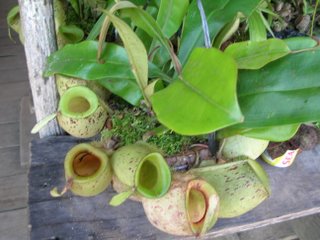 At fifteen I believed my values were immutable and formed my core, the essential part of me. When I first learned that values varied with circumstances and were changeable, I thought I was being dunned. It wasn’t long however, before I wholeheartedly embraced the idea.
At fifteen I believed my values were immutable and formed my core, the essential part of me. When I first learned that values varied with circumstances and were changeable, I thought I was being dunned. It wasn’t long however, before I wholeheartedly embraced the idea.So much so, that a good friend told me in a moment of pique, “You are the most opinionated person I know. Your only saving grace is that you are constantly changing your opinions.”
We were at the Montreal Expo. We doubted we would ever find each other again if we separated, so we were trying to agree on places we both wanted to see. I told her the crystal in the Czechoslovakian pavilion was rock bottom on my list. I lost and had to go with her. She was annoyed because I loved it, unreservedly. I took her comment, then and now, as a compliment. Since I do hold strong opinions, I figure it is best to be open to persuasion and flexible about them. In some ways, I may actually cultivate this approach. For example, my list of favourite things is very site specific and includes newspapers here while I no longer subscribe to any newspaper at home.
Early Morning Walks
In Borneo, I rise at the time of the morning called by the Iban, Dini Ai Dalam or Deep Down Dawn. It is that moment just before the sky releases it's hold on the night. The proximity to night and the early stirrings of Borneo breezes ensure that it seems cool, even if it isn't. For people of the rainforest, it is a time when many journeys begin. My journey takes me no further than a nearby park.
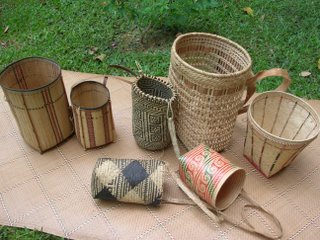 When I start my walk, it feels as if I am the only one afoot. Even the security guards at the gate are drowsing in their plastic chairs. Gradually as my eyes adjust, I can make out others. The time called, Empliau Bebungi or Calling of the Gibbons soon follows. Imagination is needed here because there are no gibbons in my part of Kuching. By the time Tampak Tanah or To See the Ground rolls around I am on my way home.
When I start my walk, it feels as if I am the only one afoot. Even the security guards at the gate are drowsing in their plastic chairs. Gradually as my eyes adjust, I can make out others. The time called, Empliau Bebungi or Calling of the Gibbons soon follows. Imagination is needed here because there are no gibbons in my part of Kuching. By the time Tampak Tanah or To See the Ground rolls around I am on my way home.The naming of the parts of the day for the Iban appears to be similar in some respects to the naming of the caribou by the Dene and of snow by the Inuit. For people who are connected with their environment, what matters gets noticed, described and shapes their world. So I hug the phrases close to me.
Early morning walks have become one of my favourite things in Borneo. We visited Mulu National Park last weekend, walking miles to and through caves and still I missed my early morning walks. It’s not a matter of endorphins as I only walk, never run or jog and only for an hour. I prefer to believe it is the magic of that hour in the rainforest.
Borneo Post
On my way back home, if it is there, I pick up a copy of The Borneo Post at the gate. My advice to people visiting another country is to read the newspaper. I follow my own advice. It gives a sense of what matters. My reasons for enjoying the paper parallel those of Somerset Maugham,who savoured The New Straight Times, a Singapore newspaper, when he was in Malaysia, for the quality of the writing and its local colour. Maybe too, like him, I will one day write more about it.
I read about the terrible vulnerability to fire of a longhouse with 135 doors and many open hearths. How a shouted warning from a neighbour, up in a nearby coconut tree, can save all the lives. A muted blessing since it leaves them to watch the conflagration of their home. Sarawak unfolds before me in the newspaper. “Running amok”, a expressive phrase we have borrowed from Bahasa Malaya to describe a person gone violently, uncontrollably mad, leaving havoc his wake, is uncommon but still happens. In Malaysia it is almost always associated with a parang or panga, a large, sharp blade readily available in most rural homes.
A riveting tale of maternal mortality averted is painstakingly laid out by a journalist. A Penan, one of the nomadic hunter and gatherers who still live deep in the rainforest, in a cashless economy, manages to bring his wife who is in prolonged labour, hundreds of miles downriver to the coast, where she is transferred to hospital. It is almost, but not quite, a fool’s journey. They start off when they are already in trouble. I imagine the father knowing, as he surely must know, either he gives it a try or he loses his wife.
There is no regular transport to or from his area. The labouring woman, the father and their 8 year old son hitchhike on logging rafts, Chinese traders and longboats. The agonizing trip and the assistance offered to the distressed woman are detailed. It is a convoluted water journey to a place he has never been, that delivers his small family to a far off sea. How, one wonders, have the mother and baby survived? We read about this heroic story because the father and son are now stranded without cash in the coastal town of Miri. Almost before the ink is dry however, money has been raised to transport them home. Even so, it may take them weeks to return home.
For someone who wants to motivate health workers about maternal mortality, this article is a gift. So too are the management articles that reflect Malaysian realities, the regular updates on the current Hand, Foot and Mouth epidemic and the useful critiques on local environmental impact assessments. The newspaper has become one of my favourite things.
Tropical Fruit Juices
 Everywhere is SE Asia you can find fresh tropical juice. Coconut juice can be drunk straight from the coconut and costs about 30 cents. Pink guava, fresh lime with a salted plum added, leechee, pineapple, orange, watermelon and mango juices are available even in smaller stalls. My favourite is Aloe Vera juice made by peeling the long cactus spikes, slicing the pulp into stripes and soaking it in water. The pulp is jellied so can be chewed. It is sold in small plastic bags tied with rubber bands. We collect ours from a local shop where it comes is groups of ten for 15 ringet or about $4.00. During Ramadan, a big time for fresh juices, watching men push sugar cane through what looks like a washing machine ringer to produce sugar cane juice is a sure draw for me. Fruit juices are another of my favourite things, even canned juices such as jellied water grass, soya milk and ginger drinks.
Everywhere is SE Asia you can find fresh tropical juice. Coconut juice can be drunk straight from the coconut and costs about 30 cents. Pink guava, fresh lime with a salted plum added, leechee, pineapple, orange, watermelon and mango juices are available even in smaller stalls. My favourite is Aloe Vera juice made by peeling the long cactus spikes, slicing the pulp into stripes and soaking it in water. The pulp is jellied so can be chewed. It is sold in small plastic bags tied with rubber bands. We collect ours from a local shop where it comes is groups of ten for 15 ringet or about $4.00. During Ramadan, a big time for fresh juices, watching men push sugar cane through what looks like a washing machine ringer to produce sugar cane juice is a sure draw for me. Fruit juices are another of my favourite things, even canned juices such as jellied water grass, soya milk and ginger drinks.Food Displays
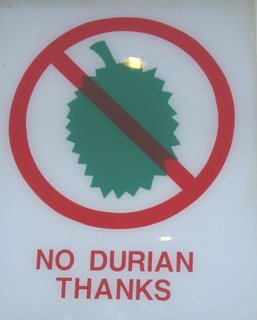 The local food stands with fresh forest produce, dried and fresh fish and piles of fruit and veggies are favourites. I love to see the different arrangements, learn about local availability and taste new and unknown varieties of fish, fruit and vegetable. I like the sense of discovery when I see a new item, taste it, and then see where it grows. Among the fruits I continue to be astonished by dragon fruit from a cactus, snake fruit from the rainforest palms, mangosteens, star fruit, longons, leechies, rambutans, mango apples, and durian. It is as difficult to describe the different tastes. Imagine trying to explain the flavour of pineapple when you only know apples and oranges.
The local food stands with fresh forest produce, dried and fresh fish and piles of fruit and veggies are favourites. I love to see the different arrangements, learn about local availability and taste new and unknown varieties of fish, fruit and vegetable. I like the sense of discovery when I see a new item, taste it, and then see where it grows. Among the fruits I continue to be astonished by dragon fruit from a cactus, snake fruit from the rainforest palms, mangosteens, star fruit, longons, leechies, rambutans, mango apples, and durian. It is as difficult to describe the different tastes. Imagine trying to explain the flavour of pineapple when you only know apples and oranges.Durian requires a special section of its own. It takes a while to get used to it. We are just getting into durian season now. I know people who are planning trips to Sarawak who have waited for durian season. It is the only fruit I know that is actually forbidden in places such as airplanes and hotels because of the strong smell. The taste however is heavenly, something like vanilla cream cheese laced with marshmallows. People who love it are avid and the line ups at fruit stalls now are long. The fruit itself is large and covered with hard spikes
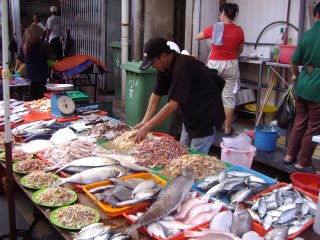
Among vegetables, the square beans, ruffled beans, midin or fiddleheads, long beans and a small green pepper a bit like cucumber, are wonderful just to look at never mind to taste. I am still looking for names for some of them. Fish stalls are full of dry and fresh fish I have never seen. What I can do is try them all. Menus are not much help since most are simply called fish dishes. People may not have names for them all but they know what they like. Dried fish and even fresh fish purchased at the last minute and carefully packed, are frequently taken as gifts when going to another area. I have a theory that half the cardboard boxes in the plane luggage hold, and there are many, are full of fish.
Baskets
Without a doubt, a lifetime passion for baskets has followed me. I began dissembling my vast collection before I came to Sarawak when it threatened to push me out of my own home. I found by giving baskets away to friends who appreciated them, I got to continue to enjoy them twice over, once for the memories of where and when I obtained them and once for the appreciation by others of their innate beauty. I most enjoy them when they are in regular use. I have resisted collecting baskets here. I take pictures of them instead of owning them.and appreciate them vicariously though my friends. It works, sort of. It is good to learn to appreciate things without possessing them.
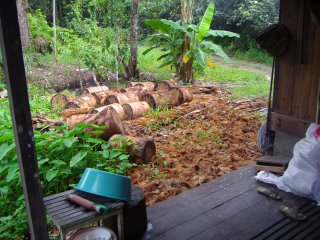
Starter Kits
Another of my favourite things is discovering something about which I know nothing. Usually some kind of starter kit is needed. My kind of starter kits cannot be bought, yet anyway.
When I entered medicine, my old Sea Ranger leader came round to wish me well. Things were financially rather bleak. She was a housewife, so her visit and the ten dollars she gave me represented a major show of solidarity. I knew ten dollars would feed me for a month on rice, wieners and frozen peas, but I wanted to acknowledge the extravagance of her gift. So after some consideration I decided to give myself a starter kit of Jazz, something I had heard about, thought I would like, but about which I knew nothing.
With the ten dollars I managed to buy a thin paperback about jazz and three vinyl records from the remainder bin, Sketches of Spain by Miles Davis, The Composer of Desafinado by Carlos Jobin with Ipanema on it and one by Thelonius Monk. Maybe I liked the cover art, or maybe, not knowing any of them, I based it on price. It took me a while to get into Monk, but the other two records and paperback were the best possible introduction to Jazz. It opened a small window on a whole world that continues to bring me enormous pleasure and serves as a constant reminder of the importance of support.
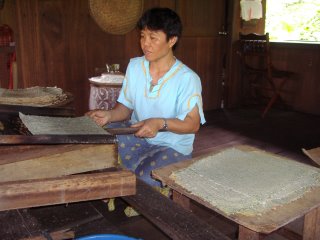 I am working on a starter kit about sago. Sago biscuits are one of the tourist items in Sarawak. While I have heard of sago pudding and tasted sago biscuits, now I am learning how it is harvested in logs from the forest, floated down the river to the mouth and then milled into powder flour and beads for making food. The effort seems enormous. At the cultural village a woman starts with the cut logs, goes through the whole process using a grinding stone and large frame sieve and then sells her tiny beads of sago. I have yet to find out why it is important in this area but I am still working on it. Some starter kits need to be developed.
I am working on a starter kit about sago. Sago biscuits are one of the tourist items in Sarawak. While I have heard of sago pudding and tasted sago biscuits, now I am learning how it is harvested in logs from the forest, floated down the river to the mouth and then milled into powder flour and beads for making food. The effort seems enormous. At the cultural village a woman starts with the cut logs, goes through the whole process using a grinding stone and large frame sieve and then sells her tiny beads of sago. I have yet to find out why it is important in this area but I am still working on it. Some starter kits need to be developed.Wild Flowers
I enjoy discovering the wild flowers of a place, where they are found and when they bloom. It makes me feel more linked or connected to the place. On canoe trips I take pictures and press flowers. In new places, I walk and drive the rural roads on the outlook. I record the sites and dates and return when I can. I have identified “new-to-me” flowers from a car window at 100 kpm. This is not as difficult as it sounds. If you know the height and colour of the usual wild flowers found in an area, what sticks out is likely to be something rare and unusual. When you stop and verify it is so, your companions are simply amazed and you have established a certain reputation. Imagine such a one being in a place where the wild flowers, the common wild flowers, are orchids and pitcher plants.
I am not alone in this love of orchids and pitcher plants. Rare and beautiful orchids and exquisite varied pitcher plants are on sale for pennies in many places. But unless the buyer is very careful, such plants do not do well in urban gardens. Surprisingly, they like the shelter, humidity and fecundity of the rainforest more than city yards. So there are lots of dead or dying orchids and pitcher plants around.

The people selling the plants are barely surviving on the margin. The issue is a difficult one, similar to the survival of gorillas in mountain forests in Rwanda or elephants in Kenyan game parks. The solution needs to be approached in ways that benefits local people and rewards them as the protectors of this bounty. Lots of innovative programming is being done in Africa at present, I sure hope it gets to Borneo in time. This is one of the aspects of sharing my favourite things. I know we can only really protect and care for the things we know well. I want others to enjoy them but I feel an overpowering need to protect them. It’s a battle I don’t win all the time, but I keep trying.
Photos: Pitcher Plants, Dragon fruit, NO Durian sign; fish stall in market, sago logs, refining sago, baskets and common roadside bamboo orchid.
Labels: Sarawak


4 Comments:
This is a beautiful chronicle ... and I'm so glad you're writing it.
Perhaps you could offer it as a book later ...
I LOVE the names for different times of day, so wonderfully descriptive!
I also love baskets. I don't think it has anything to do with my uterus though (although my baskets are rarely lidded - nor is my uterus). I think it has to do with hands. Baskets that are made by hand have felt a human touch and hold the wisdom of generations of hand-workers. I love baskets for their secrets because I cannot make them. I love them because they are made out of available materials (sticks and birch bark in northern Canada, wild grasses in Scotland, etc.) . I also love them because they are practical. Not enough keepsakes are practical. I could probably think of many other reasons I love baskets!
Thanks, Moof.
Welcome medstudentitis. Lovely comment. I deleted the bit about the uterus connection to baskets, it like I was blaming psychiatrists. What dazzles me most about baskets is that women, usually, go to such trouble to make a thing of beauty out of a practical item of daily use.
What a lovely expansion you have given us of your world. I also love the names for the different times of day; I never imagined that the hour or so around dawn would have several different parts. Do the other hours of the day have as many sections? Or perhaps only sunset?
And the fruit! Oh my goodness! My mouth waters and pangs of longing burst from my breast. Good, fresh fruit is the one thing I miss more than any other in the cold northern climes of Alaska. Until now, the fruit I have been missing was only the usuals--peaches, apricots, pineapple, kiwi. The variety you describe here is truly amazing. Thank you for providing such food for the imagination.
Post a Comment
<< Home